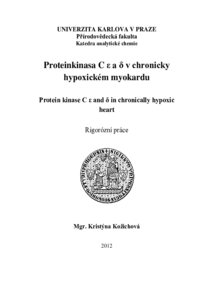Proteinkinasa C ε a δ v chronicky hypoxickém myokardu
Protein kinase C ε and δ in chronically hypoxic heart
rigorous thesis (DEFENDED)

Reason for restricted acccess:
The annexes of the thesis or its part are inaccessible in accordance with article 18a (7) of The Code of Study and Examination in conjunction with Article 9 of the Rector’s Directive No. 6/2010.
View/
Permanent link
http://hdl.handle.net/20.500.11956/47462Identifiers
Study Information System: 120095
Collections
- Kvalifikační práce [20329]
Author
Referee
Martínková, Markéta
Faculty / Institute
Faculty of Science
Discipline
Clinical and Toxicological Analysis
Department
Department of Analytical Chemistry
Date of defense
23. 4. 2012
Publisher
Univerzita Karlova, Přírodovědecká fakultaLanguage
Czech
Grade
Pass
1 Abstrakt Adaptace na chronickou hypoxii vyvolává kardioprotekci, která má dlouhodobé účinky. Ukázali jsme, že v mechanismu tohoto typu kardioprotekce se uplatňuje proteinkinasa C (PKC). Doposud nebylo objasněno, jaká isoforma PKC je zde zapojena, ale nejpravděpodobnějšími adepty jsou isoformy ε a δ. Cílem této studie proto bylo sledovat změny exprese a lokalizace PKC ε a PKC δ po adaptaci na chronickou hypoxii. Ukázali jsme, že adaptace na chronickou hypoxii vede k aktivaci a translokaci PKC δ na sarkolemální a mitochondriální membránu. Z naší studie vyplývá, že PKC δ hraje v mechanismu kardioprotekce indukované chronickou hypoxií důležitou roli.
1 Abstract Adaptation to chronic hypoxia confers long-term cardioprotective effects. We have shown, that protein kinase C (PKC) is involved in this cardioprotective phenotype. It has not been elucidated, which PKC isoform plays a role, but the most likely candidates are PKC ε a PKC δ. Therefore, the aim of this study was to analyze the expression and localization of PKC ε and PKC δ after the adaptation to chronic hypoxia. We have shown that adaptation to chronic hypoxia caused the activation and tranlocation of PKC δ to the mitochondrial and sarcolemmal membranes. Our study suggests that PKC δ plays an important role in the mechanism of cardioprotection induced by chronic hypoxia.
